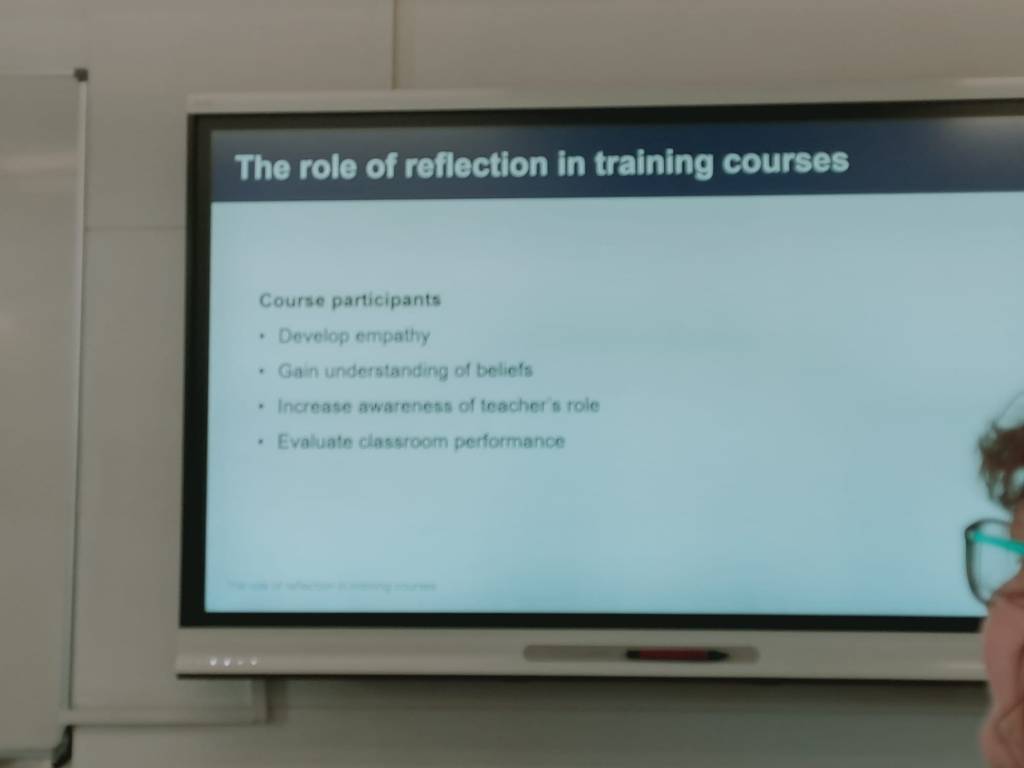The Future of Training Conference – International House London, Nov 11th 2023
I attended and presented for the second time at the amazing Future of Training conference at IH London last Saturday, Nov 11th. It was a hybrid conference, but as I love catching up with friends, I decided to attend in-person. The conference is perfect for teacher trainers and academic managers. My talk was entitled Shaping future teachers: Insightful observations & dialogues in CELTA & CertTESOL programmes and slides can be found here ( please send me an email request )
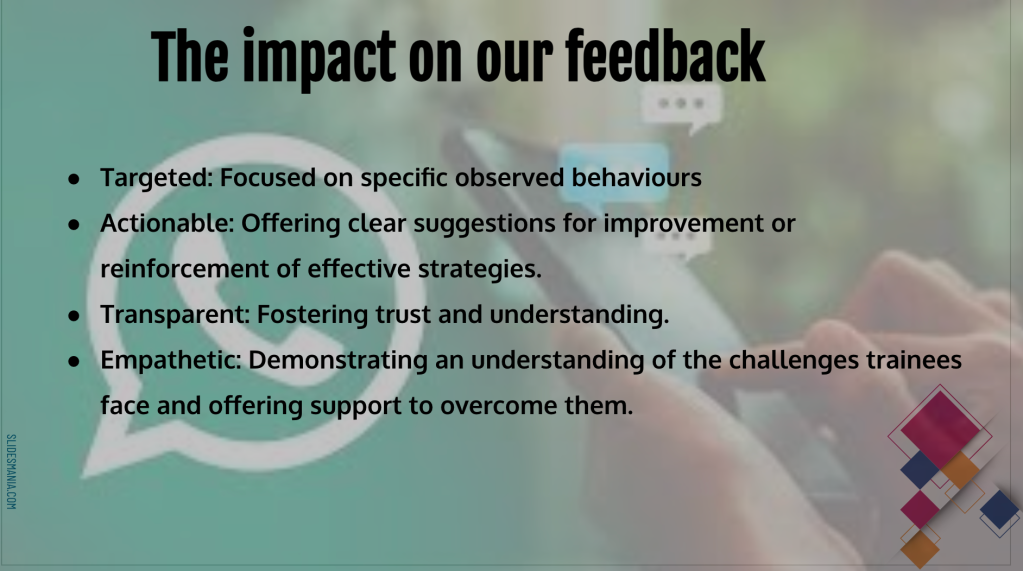
I have also watched amazing talks by Rose Aylett, Richard Chinn, Danny Norrington-Davies, Ri Willoughby, Neil Harris, Simon Dunton and many others! Thank you all presenters and IH House for the amazing conference! I’m looking forward to next year’s!
Here are some photos of the day.


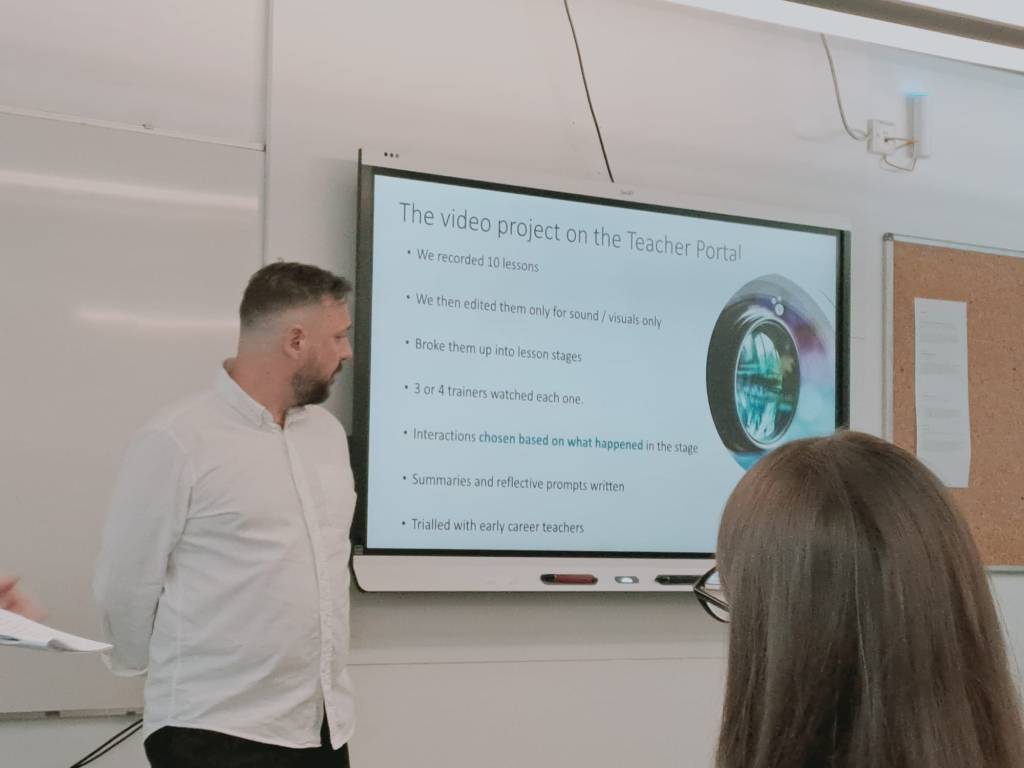


How to boost your confidence and start writing for ELT magazines
Have you ever written for teacher magazines? It’s a way to share your teaching experiences and insights with a broader audience and it has so many benefits – supporting your professional development, helping you grow as a teacher, and showcasing your expertise to peers and mentors. Besides, it connects you with fellow teachers, creating a sense of camaraderie and support while allowing you to exchange valuable teaching strategies and ideas. But, I get it, it can be a bit intimidating if you’re new to it. So, let me give you some friendly advice to boost your confidence!

1. First things first, have you ever had a lesson or activity that just went amazingly well, or maybe you tried something new in your classroom recently? Well, here’s a tip: start by writing about those experiences. While you’re teaching, jot down some notes, like what worked, how your students reacted, and what you learned from it. Think about the context, too—like the age group and skill level of your students. Trust me, this reflection is gold when you sit down to write your article.
2. Now, if I’m honest with you, I get it if you’re not quite ready to jump into writing for a magazine. So, here’s a more relaxed approach: start a blog or write on Linkedin ( Linkedin has a “write an article” feature as an option to write a post) Seriously, it’s less intimidating and a great way to build your confidence over time. I started that way, and it really helped me get comfortable with sharing my thoughts.
3. But here’s the big one—write about what you’re passionate about! You know, things that really get you fired up. It makes writing so much easier. Why? Well, because your enthusiasm shines through your words, and that’s what readers love. Plus, it’s just more fun to write about stuff you care deeply about, right?
4. Now, let me ask you a couple of questions. Ever thought about showing your article draft to a fellow teacher friend before you submit it for publication? It’s a smart move. They can give you honest feedback and help you polish it up. Collaboration can make your article even better!
5. And here’s another thought: have you ever analysed articles in the magazines you want to write for? You know, look at their structure and style. What kind of topics do they usually cover? This research can be a game-changer, helping you write articles that really resonate with their readers.
6. Another fantastic way to gain writing experience and build your confidence is by reaching out to ELT bloggers. Here’s the deal: if you’re an avid reader of ELT blogs, why not try contacting the blog writers and asking if they accept guest writers? It’s a great way to get your foot in the door, and you know what? Many bloggers are open to guest contributions. The beauty of this approach is that it allows you to dip your toes into the world of publishing without the pressure of a full-fledged magazine article.
7. Lastly, remember to plan and organise your writing. Create a clear outline, divide it into sections, and make sure it flows logically. And don’t forget to revise and edit your work. A polished article is a professional one.
So, there you have it— 7 tips to help you feel more confident about writing for teacher magazines. I believe in you, and I know you’ve got valuable insights to share with the teaching community. So, go ahead and start writing—you’ve got this!
These are some ELT magazines/organisations that welcome guests contributions:
https://www.modernenglishteacher.com/write-for-us
https://www.elgazette.com/write-for-us/
https://ihworld.com/ih-journal/write-for-us/
IATEFL Voices – editor@iatefl.org
Humanising Language Teaching – https://www.hltmag.co.uk/page/?pid=2168
ELT Ireland – https://www.elt-ireland.com/
TESOL ICIS newsletter (intercultural focus) newsletter.icis.tesol@gmail.com
PronSIG IATEFL ( Pronunciation SIG) – https://pronsig.iatefl.org/journal/
LT (Learning Technologies) SIG – IATEFL – https://ltsig.iatefl.org/write-for-us.php
YoungLearner SIG – IATEFL – https://yltsig.iatefl.org/get-involved/
Foodie talk – Beginner pair-work
In this blog post, I want to share an exciting pair work activity I recently conducted with my absolute beginner students (A1 level). By incorporating a Dogme approach, we fostered meaningful interactions among students, allowing them to practice vocabulary and grammar related to food. I believe this activity encouraged language production, sparked genuine conversations, and generated emergent language from the students themselves. I am so proud of them!


Activity description
To kick off the activity, I assigned homework to my students, instructing them to take a picture of the food in their fridges. The following day, I grouped them into pairs, ensuring they had the opportunity to interact with different classmates. The task was simple yet engaging: they had to discuss the contents of their fridges, asking questions such as “Do you have __ (food)?” and encouraging follow-up questions about their partner’s food preferences and habits.
The Dogme approach
Embracing the Dogme approach, which promotes student-centred and conversation-driven learning, this pair work activity allowed students to engage in authentic and meaningful exchanges. By focusing on their own experiences and knowledge, students were encouraged to actively construct language and explore the topic of food in a natural setting. As a result, this facilitated their language production that was relevant and personalised to their lives, promoting a deeper understanding of the vocabulary and grammar they had learned. Yay! 🙂

Emergent language and genuine questions
One of the wonderful aspects of this activity was observing the emergence of new language and the generation of genuine questions. Students didn’t rely on pre-scripted questions; instead, they engaged in spontaneous conversations, seeking clarification and expressing their own preferences. For instance, one student asked, “Do you have a mango?” and the response prompted an opportunity to practice negation: “No, I don’t have mango.” This organic language development not only reinforced grammar concepts but also built confidence in the students’ ability to communicate effectively.
>> You can find parts of my class here and here
Clarifying language structures
During the activity, one student sought clarification on how to respond to a question using the phrase “Do you?” With their eyes scanning the board for guidance, they asked, “Teacher, yes I have?” In such instances, it is important to provide immediate and concise guidance. I responded by saying that they could answer with “No, I don’t” or “Yes, I do.” Additionally, I emphasised that they could also expand their answers by saying, “Yes, I have bla bla bla,” without further explanation. This approach allowed them to become more comfortable with using different sentence structures while maintaining the flow of the conversation.
Cultural sensitivity and meaningful discussions
It is crucial that teachers create a safe and inclusive learning environment for our students. During the pair work activity, one of my students asked what beer was, to which I explained that it was an alcoholic beverage. This prompted laughter from one student who mentioned, “I don’t drink beer” due to religious reasons (he is Muslim). By fostering an atmosphere of respect and open-mindedness, we encourage students to share their perspectives and engage in meaningful discussions, further enriching their language learning experience.
Intentional error correction
Throughout the activity, I intentionally refrained from correcting all the students’ mistakes. This approach allows learners to focus on fluency and encourages risk-taking. By prioritizing communication and expression over accuracy, students feel more at ease to participate actively without the fear of constant correction. However, it is important to strike a balance between fluency and accuracy, providing feedback and addressing errors during appropriate moments, such as in subsequent lessons or individual feedback sessions.
Through this simple pair work activity, we have seen the incredible potential of absolute beginner students to engage in meaningful conversations. By providing them with the necessary scaffolding and unleashing their natural curiosity, we have shattered the notion that speaking is reserved for more advanced learners. My students have proven that with the right support and guidance, they can confidently express themselves and dive into authentic interactions. That’s why I wholeheartedly believe that we can encourage absolute beginners to speak in a meaningful way. They can do it once scaffolded.
Book launch: Using Video to Support Teacher Reflection and Development in ELT
I am absolutely thrilled to announce the release of our latest book, Using Video to Support Teacher Reflection and Development in ELT. Holding my author copy in my hands is an indescribable joy and a true dream come true, especially considering that I haven’t yet completed my PhD! This remarkable achievement would not have been possible without the collaboration and expertise of two exceptional educators and mentors, Laura Baecher and Steve Mann.

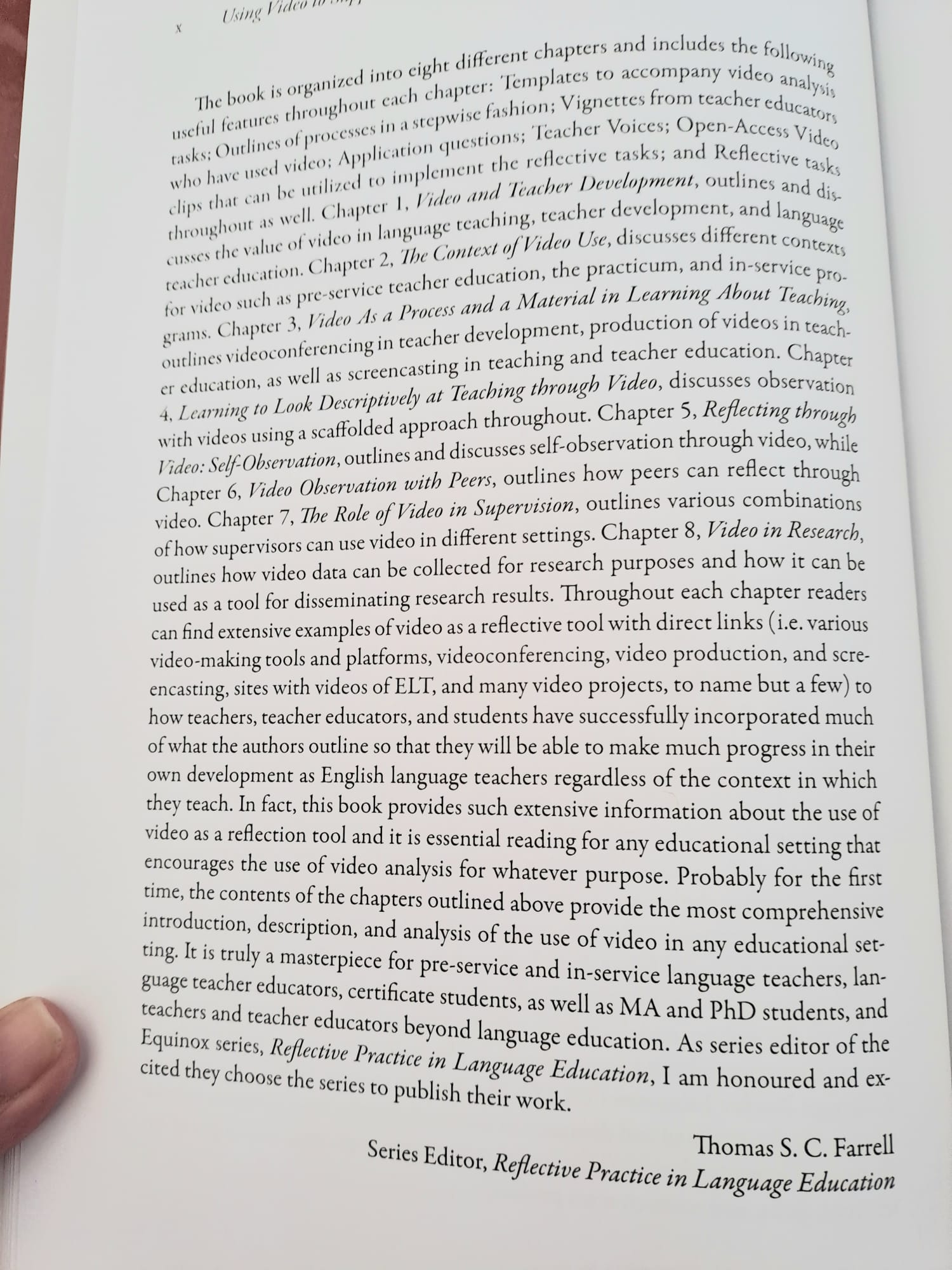

I am particularly grateful to Steve Mann, who originally invited me to co-write this book with Laura 2 years ago. Even back then, he was aware of my aspirations to pursue a PhD and my keen interest in the use of videos for teacher development. Steve’s unwavering support has been instrumental throughout my academic journey, from my days as a student at Warwick University, where he was my supervisor, to this current endeavour. Working alongside both Steve and Laura has been an invaluable learning experience and a significant milestone in my growth as a researcher and educator.
Our book, the result of countless hours of meticulous research and collaboration, aims to serve as a valuable resource for teachers, educators, student teachers and trainers. We have endeavoured to provide practical insights, evidence-based strategies, and thought-provoking reflections that can enhance the effectiveness of using videos in ELT.
If you would like to order a copy of the book, simply quote the code “UV” for a 25% discount when placing your order at https://www.equinoxpub.com/home/using-video/.
Drill power
You either love it, or hate it. There is no in between!
Drilling, often met with skepticism by some trainers and teachers, holds a place of undeniable value within the language classroom( and in my heart). Based on my experience teaching absolute beginners and my strong belief in effective teaching approaches, I wanted to take a moment to discuss drilling in the classroom. You see, I’ve come to appreciate the value of drilling, and I wanted to share some of its merits with you. It’s all about being open-minded and willing to challenge the status quo, which is something I hold dear.
Why do I like drilling, you ask? Here are some reasons.

1) Drilling ignites accuracy and automaticity
One of the key benefits of drilling exercises lies in providing students with focused practice that promotes accuracy and automaticity. By repeatedly engaging with language patterns, structures, and vocabulary in a controlled manner, students internalise language rules and develop a more intuitive grasp of the language. This heightened accuracy and automaticity establish a solid foundation for effective communication, enabling students to produce language more fluently and confidently.
2) It enhances pronunciation and phonological awareness
Contrary to popular misconceptions, drilling plays a crucial role in developing accurate pronunciation and improving phonological awareness. Through targeted repetition and imitation, learners refine their pronunciation, intonation, and stress patterns. When working with my beginner students, I always emphasise the importance of speaking naturally, rather than sounding robotic. That’s why, during drilling exercises, I focus not only on individual words but also on language chunks and collocations, all delivered at a ‘normal’ pace using connected speech. By doing so, I encourage them to develop a more authentic and fluent speaking style. Also, drilling exercises empower students to recognise and reproduce the sounds and rhythm of the language, enhancing their overall oral proficiency and communicative clarity.
3) Drilling facilitates immediate feedback and error correction
Drilling provides a unique opportunity for immediate feedback and error correction. As students engage in repetitive practice, we can closely monitor and promptly correct errors, offering valuable guidance and clarification. I also nominate individual students to drill. This timely feedback empowers our students to address misconceptions, refine their understanding, and make necessary adjustments, ensuring more accurate and precise-ish language production.
4) It helps students build confidence and fluency
Significantly contributing to learners’ confidence levels, drilling becomes an essential tool, especially for those who are new to the language or struggle with speaking (common characteristics of beginners). Through repetitive practice, students gain familiarity with language patterns and structures, boosting their confidence in using the language. As learners experience success and witness their progress, their self-assurance grows, leading to increased participation and a greater willingness to take linguistic risks. It’s a win-win situation!
5) Drilling harnesses the power of language patterns
Drilling enables our students to internalise language patterns and chunks, making them readily available for spontaneous language production. By repeatedly practising language structures, students develop a deeper understanding of how the language works, allowing them to utilise these patterns flexibly and creatively in authentic communication situations.
6) It lays the foundation for language development
Drilling exercises serve as a valuable tool for building a strong language foundation, particularly in the early stages of language learning (A1 and A2 learners). The repetitive nature of drilling helps students solidify fundamental vocabulary, grammar, and sentence structures, which serve as the building blocks for more complex linguistic skills. This solid foundation helps set the stage for future language development and proficiency.
So, there are many reasons to love drilling 😉
However, it is important to acknowledge that drilling should be used purposefully and in moderation ( we don’t want our students to turn into parrots!), complementing a well-rounded language curriculum that incorporates communicative activities, authentic materials, and meaningful contexts. By recognising the benefits of drilling and integrating it thoughtfully into instruction, we can foster accuracy, fluency, confidence, and linguistic competence in our learners.
It is also vital to establish a balanced approach to language teaching, recognising the value of drilling alongside other teaching techniques, to support the diverse needs of our students and promote their overall language development.
And you, do you drill in the classroom? If so, in which moments?
Breaking into English Teaching: How to Get Started Without Experience
Are you considering a career in English teaching but lack teaching experience? If so, you’re not alone.
Starting out can be tough, and many aspiring teachers worry about whether they’re really cut out for the job. I know I did when I first started teaching English at 19 years old as a 3rd-year undergrad student at UFRJ, in Rio de Janeiro, Brazil. I was lucky to find an opportunity at CLAC that was more like an intern position so I could get experience. I made plenty of mistakes in the beginning, but I was lucky to have a supportive group of colleagues who were always there to offer guidance and advice.
Looking back, those early years were some of the most challenging but also the most rewarding. They taught me so much about the craft of teaching and helped me grow both personally and professionally.
Now, as a senior teacher and a teacher trainer, I know how important it is for novice teachers to have a supportive community of colleagues who can help them navigate the ups and downs of the profession. That’s why I’m sharing some practical ideas to help you get started with teaching English and overcome some of the common fears that aspiring teachers face:
- Observe other teachers and take notes
Trust me, observing other teachers in action is one of the best ways to learn about teaching techniques and classroom management. It doesn’t have to be formal or complicated – you can simply ask a colleague if you can sit in on one of their classes. Take detailed notes on what you see, and analyse their teaching style. What do they do well? What could be improved?
- Create your own lesson plans and materials
Developing your lesson plans and materials can be a great way to better understand the teaching process. Start by choosing a topic you feel confident teaching, and create a lesson plan around it. This will help you to identify areas for improvement and develop your own teaching style. You can also create your own worksheets and other materials to use in class.
- Join a teaching community or association
Feeling supported and connected to other teachers can make all the difference as you develop your skills. Look for online communities, social media groups or local teacher groups/Teacher associations where you can share ideas, ask for feedback and connect with other teachers. It’s a great way to get inspiration and advice and to build connections with other educators.
- Offer to tutor or teach in your spare time
Teaching as much as possible is one of the best ways to build your teaching skills and confidence. You can offer your services through local community centres, schools or online tutoring platforms. Teaching one-on-one or small groups can be a great way to get experience and build your skills.
- Attend a teacher training course
If you’re looking for more formal training, attending a teacher training course such as CELTA or CertTESOL is a great option. These courses provide hands-on training and support for those with little or no teaching experience. They can be intense, but they’re a great way to gain practical experience and build your confidence.
- Volunteer to teach English
Volunteering to teach English can be a great way to gain teaching experience while making a difference in your community. Look for local organisations or community centres that offer English language classes, and offer to volunteer your time and skills. This can help you develop your teaching skills, build confidence, and make valuable connections in the teaching community.

Remember, becoming a teacher is a journey that requires hard work, dedication and passion. By following these practical ideas and seeking out opportunities to develop your skills, you’ll be well on your way to becoming a successful English teacher.
Best of luck!
Why do we drink tea? B2/C1 lesson plan
Hi, teachers.
I’ve created this LP with B2/C1 students in mind. It has a strong focus on cultural awareness,
conversational skills, and the subtle aspects of intercultural communication. It’s flexible
enough for both online and in-person classes. Although it’s ideally suited for group lessons to
encourage lively discussions and diverse viewpoints, you can absolutely adapt it for
one-on-one lessons by stepping in more actively during discussions and role-plays.


Level: Intermediate/Advanced – B2-C1
Time: 90 minutes ( for groups)
Learning aims:
- Enhance students’ understanding and appreciation of cultural nuances in
social practices involving tea, fostering intercultural awareness. - Develop pragmatic language skills through analysing and engaging in
culturally varied dialogues and role-play scenarios related to tea. - Strengthen conversational abilities, focusing on expressing and interpreting
humour, politeness, and social norms in intercultural communication contexts.
Workshop – Using video-based lessons effectively
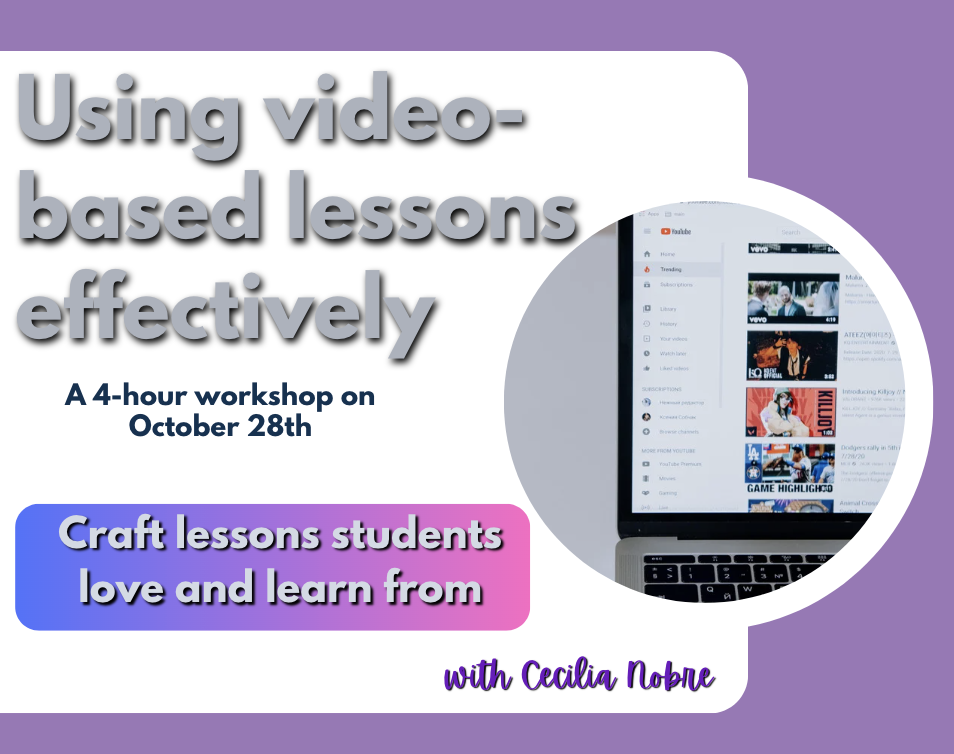
English teachers face real challenges when it comes to using videos for the best teaching results. It’s more than just playing a video and asking comprehension questions; it’s about making the most of it to help students learn. Maybe you’ve tried to use videos before, but the lesson seemed disconnected or you noticed your students’ losing interest. The time you spend searching for the right video and planning a lesson can feel pointless if it doesn’t work well. It’s tough to know you have a great teaching tool but you’re not making the most of it. The time pressure and lack of good ideas make it even tougher.
This is why I’ve created the “Using video-based lessons effectively” workshop. I’ve been in your shoes, and I’ve cracked the code. Register here
Ever wondered why video lessons can be such game-changers? Videos aren’t just fun; they’re powerful teaching tools that immerse students in authentic language scenarios, keeping them hooked and eager for more. And, trust me, students absolutely adore them!
Diving deep into the world of video lessons will ensure participants gain the skills to plan with ease, integrate smoothly, and assess effectively. For those aiming to discover the best videos, design compelling lessons around them, or measure their success accurately, support is provided.
Participants will receive the session recording, valuable frameworks (Dogme, Task-based, PPP, and more), access to an exclusive Facebook group for 2 months, and a curated list of 50 video channels to begin their exploration
Why attend this workshop? Here’s a recap of what you’ll gain:
- Find top-notch videos: I’ll point you to the best spots for engaging, curriculum-friendly authentic videos.
- Craft structured/semi-structured lessons: Master the art of planning a lesson around a video while hitting all learning objectives.
- Hone your teaching techniques: Sharpen your strategies for video lessons, ensuring your students are captivated and informed.
- Assess with confidence: I’ll share strategies for formative and summative assessments during and after video lessons.
- Integration made easy: Learn to smoothly include videos into your existing curriculum.
🗓 Mark your calendar: The workshop will be held live on Zoom on October 28th, from 17:00 to 21:15 UK time.


